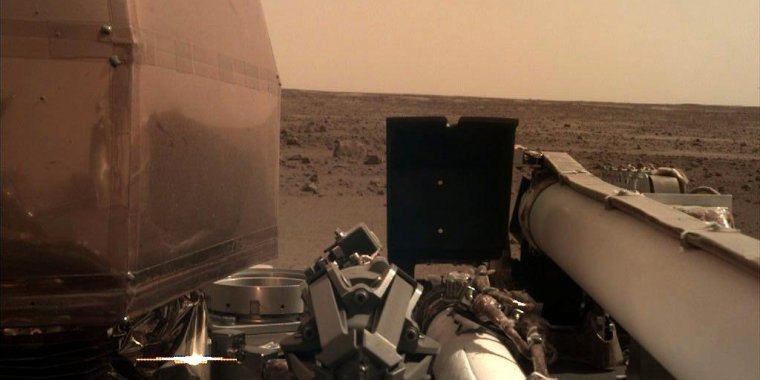| News / Space News |
NASA InSight Lander Arrives on Martian Surface
Mars has received its newest robotic resident. NASA's Interior Exploration using Seismic Investigations, Geodesy and Heat Transport (InSight) lander successfully touched down on the Red Planet after an almost seven-month, 300-million-mile (458-million-kilometer) journey from Earth.

The Instrument Deployment Camera (IDC), located on the robotic arm of NASA's InSight lander, took this picture of the Martian surface on Nov. 26, 2018. Credit: NASA/JPL-Caltech
InSight's two-year mission will be to study the deep interior of Mars to learn how all celestial bodies with rocky surfaces, including Earth and the Moon, formed.
InSight launched from Vandenberg Air Force Base in California May 5. The lander touched down Monday, Nov. 26, near Mars' equator on the western side of a flat, smooth expanse of lava called Elysium Planitia, with a signal affirming a completed landing sequence at 11:52:59 a.m. PST (2:52:59 p.m. EST).
The landing signal was relayed to NASA's Jet Propulsion Laboratory (JPL) in Pasadena, California, via NASA's two small experimental Mars Cube One (MarCO) CubeSats, which launched on the same rocket as InSight and followed the lander to Mars.
They are the first CubeSats sent into deep space. After successfully carrying out a number of communications and in-flight navigation experiments, the twin MarCOs were set in position to receive transmissions during InSight's entry, descent and landing.
"We hit the Martian atmosphere at 12,300 mph (19,800 kilometers per hour), and the whole sequence to touching down on the surface took only six-and-a-half minutes," said InSight project manager Tom Hoffman at JPL. "During that short span of time, InSight had to autonomously perform dozens of operations and do them flawlessly - and by all indications that is exactly what our spacecraft did."
Confirmation of a successful touchdown is not the end of the challenges of landing on the Red Planet. InSight's surface-operations phase began a minute after touchdown. One of its first tasks is to deploy its two decagonal solar arrays, which will provide power. That process begins 16 minutes after landing and takes another 16 minutes to complete.
The InSight team expects a confirmation later Monday that the spacecraft's solar panels successfully deployed. Verification will come from NASA's Odyssey spacecraft, currently orbiting Mars. That signal is expected to reach InSight's mission control at JPL about five-and-a-half hours after landing.
InSight will operate on the surface for one Martian year, plus 40 Martian days, or sols, until Nov. 24, 2020. The mission objectives of the two small MarCOs which relayed InSight's telemetry was completed after their Martian flyby.
With InSight's landing at Elysium Planitia, NASA has successfully soft-landed a vehicle on the Red Planet eight times. (NASA)
YOU MAY ALSO LIKE

